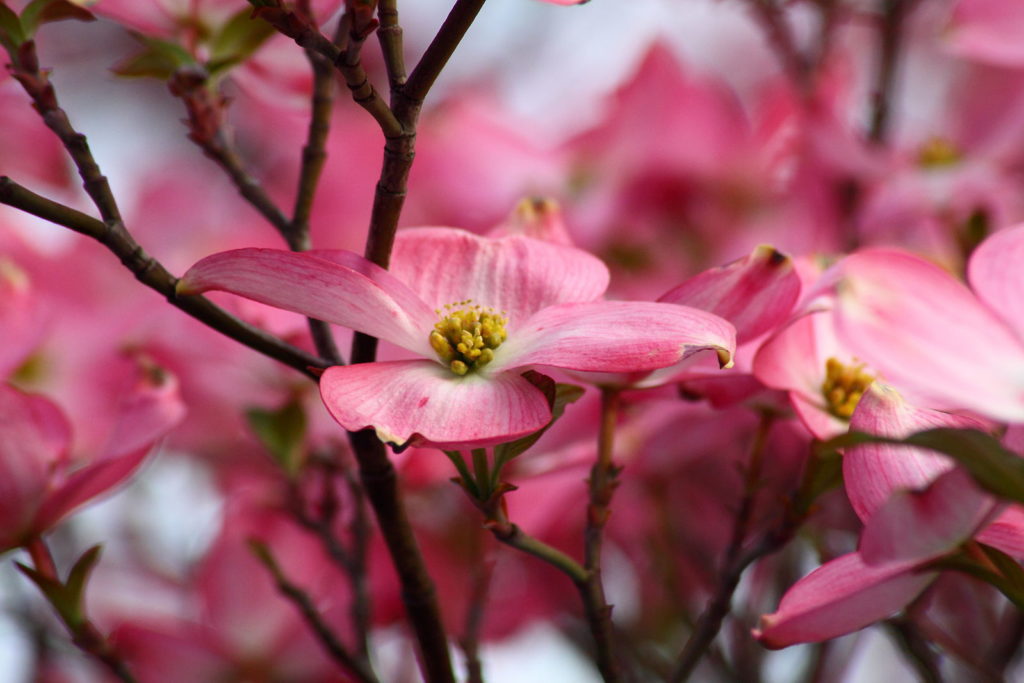My dreams never let go of the woods that surrounded me long ago, back when I lived for four years during grad school outside of the University of North Carolina in a little trailer down a dirt road. One of my most cherished memories from that time is something called a “Carolina Spring.” Now, after four decades, I’m right back in the thick of it.
Glorious spring can be found many places, particularly Virginia, Maryland, Georgia, South Carolina, Alabama—really any place where winter yields to an outburst of staggering numbers of azaleas, dogwoods, and rhododendrons. Any place where new greenery not only fills the lattice of winter branches, but explodes into cascades of emerald. Any place where sunrise is announced by a virtual orchestra of twittery birds, while nighttime is lulled by the hypnotic chirps of frogs.
A Texas Spring does not do these things. Texas Spring arrives like a flash of lightning. Crash! Forsythia and Bradford Pears erupt overnight. Boom! Photinia blaze up. Then one last flash as Bluebonnets rise up, punctuated by their taller friends—perky Indian Paintbrush.
Texas wildflowers are polite enough to remain for a spell, but the rest of it rips away like a tornado when the temperature suddenly leaps to 84 degrees, heading for 97. If you blink, you can miss it.
Not here. North Carolina’s spring is measured, gradual, dignified. It reminds me of a Baroque opera, wherein each of the characters enters in an orderly manner with a secco recitative, followed by a perfectly structured da capo aria.
 But the topography across the East Coast is so varied. Just a couple of weeks ago Hank and I were driving from Missouri through Illinois, Indiana, Kentucky, and West Virginia on the way back to North Carolina, and found ourselves weaving back and forth between spring and winter. Witnessing the staggered course of spring’s arrival gave me pause and evoked a story my mother was fond of telling me about the hickory tree.
But the topography across the East Coast is so varied. Just a couple of weeks ago Hank and I were driving from Missouri through Illinois, Indiana, Kentucky, and West Virginia on the way back to North Carolina, and found ourselves weaving back and forth between spring and winter. Witnessing the staggered course of spring’s arrival gave me pause and evoked a story my mother was fond of telling me about the hickory tree.
She found the story in a pamphlet and carried it in her purse. She held this story as her favorite metaphor for many things, particularly humanity’s slow pace of apprehending sacred truth and achieving spiritual progress. If I ever get my file boxes unpacked from our move out of Texas, I’ll find the tattered pamphlet, which I have kept. But meanwhile, the best I remember, the story goes like this:
A hickory tree, a notorious late-bloomer, watched in dismay as all the other flora donned their spring vestments. Daily, the hickory began to doubt if it would ever emerge from its stark winter clothing to be clad in new green leaves. But all living creatures, trees included, have their own time of fulfillment.
Finally, a day arrived in late spring when the buds of the hickory tree peeked open. Translucent green leaves appeared. The fine and noble hickory tree was now graced by the addition of a radiant green halo.
The story of the hickory tree reminds us that measuring growth by the standards of others is not just deceptive but is sure to distort the truth and steal joy. That’s the reason my mother told me the story more times than I can count. Always a worrier (that hasn’t changed), I fretted continually as a young person at my own position in terms of other kids. Most of what bothered me ultimately was without substance, but some of it did matter. The story of the hickory tree helped not just me, but her, too, get through several stages of our lives together.
One thing for sure: our North Carolina hardwoods are green now. But heading up to Cincinnati this week for the Great Midwest Homeschool Conference, we still drove through a few mountainous areas in West Virginia where the sun has yet to warm the hollows enough to bring on full-blown spring. We even saw a few stretches where our eyes thought we’d reentered winter.
Like the hickory tree, those trees’ time hasn’t come yet. They linger still within winter’s starkness. But hidden in their late emergence lies the promise of a more dramatic autumn ahead, one wherein their blazing colors will grace the cool mountains long after the valleys below have lost their beauty.
For now, a species of unknown bird sounding eerily like my alarm clock when its batteries are low has taken to rousing me before sunrise. I fling open the door to the deck, step out in wonder, and breathe in the fragrance of blooming shrubbery while the sky turns into a tapestry of gold, pink, and grey. I am glad to be back in my Carolina Spring.



